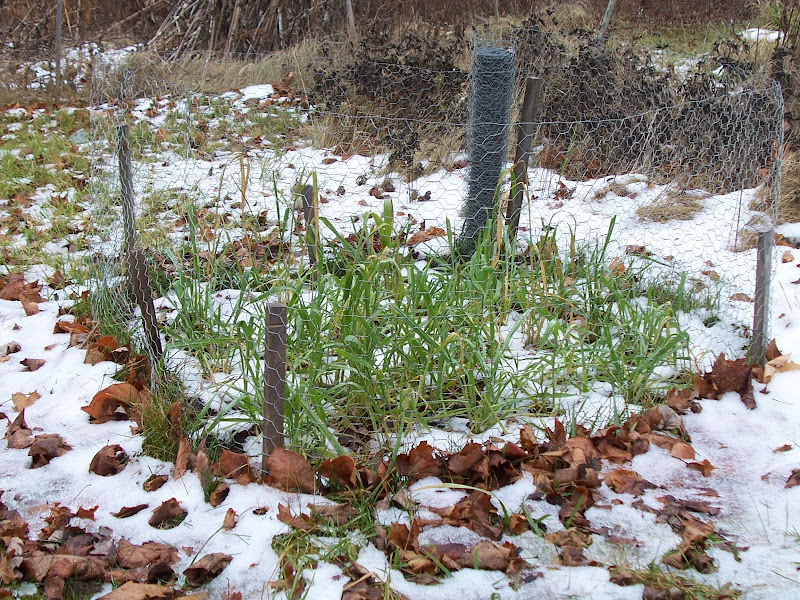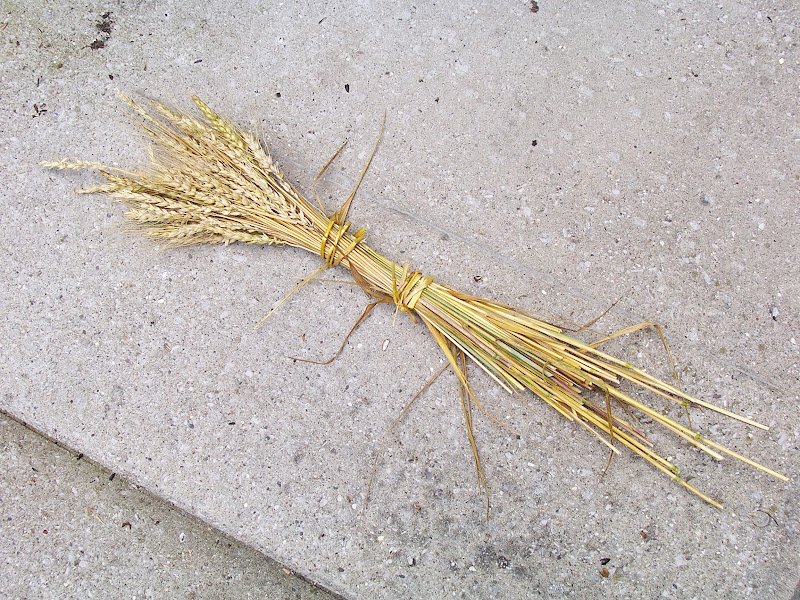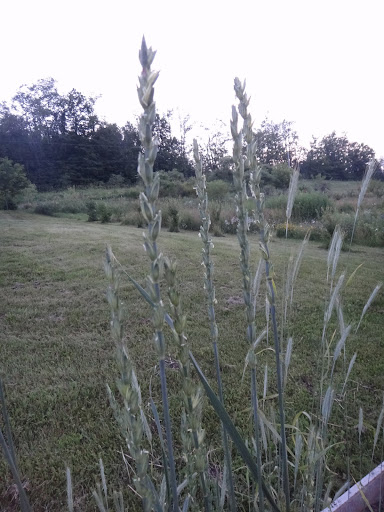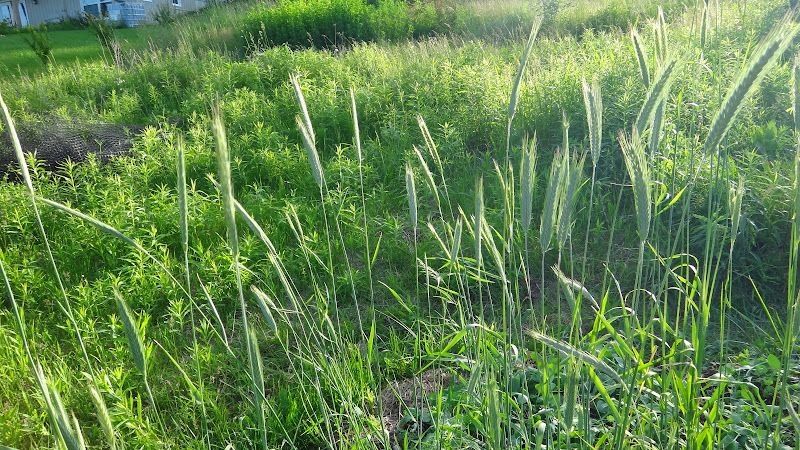|
|
Post by MikeH on Mar 16, 2012 3:55:13 GMT -5
Attachments:
|
|
|
|
Post by stratcat on Oct 4, 2012 22:21:06 GMT -5
This summer I started some of the 'Ezeer Thresh' perennial wheat sample I received in January, 2009. It was still quite viable; 36 of 39 seeds sprouted! Thanks, Bunkie. I dug up the lawn and ended up with 32 plugs planted in the chicken wire. It's mulched, but not with straw.  |
|
|
|
Post by MikeH on Oct 7, 2012 7:31:28 GMT -5
hey jo, if you want i can send you some of my perennial rye. it's going on 4 years now, returning each year with a bounty! i agree about wheat, too. am still experimenting with a small amount of the Ezzer, and Einkorn, and other grains, for our food and our animals. bunkie, When you say it's coming back with a bounty, do you mean that it is multiplying or that the yield is increasing as the roots establish themselves or both? Have you been seeding more plants? Do you any feel yet for yield? How has it been for ergot? Got any pictures of this year's results? Questions, questions, I know but I'm where you were 4 years ago and am interested in a peak into the future. The Ezzer that I got from you did well - I tripled the seed that you sent me. |
|
|
|
Post by bunkie on Oct 7, 2012 11:41:25 GMT -5
bunkie, When you say it's coming back with a bounty, do you mean that it is multiplying or that the yield is increasing as the roots establish themselves or both? the roots were established the first year, from what i can see. the bounty is that the plants are yielding every year, looks like about the same amount every year. i have not measued it, but from 75 minus plants, i get a 33 gallon bag full of unthreshed seeds and stems every year since planted. i will be threshing them very soon. the last year i seeded three other trial rye varieties that tim sent me (and others for trial). the only variety i haven't planted is the one that shatters. have to find a place away from these for it...next year. i also seeded the rest of the Ezzer Wheat i had leftover. the amount of ergot seems to diminish eaach year. it's a mysteery to me cause we have been having long cold wet springs which is part of what causes the ergot, from what i understand. very unusual weather for us here in the spring. i am late in harvesting, but will do so this week before the rains come. will try and take some pics to post. that's how we learn mike! i was full of them, and still am, four years ago, too! problem is i have a difficult time 'recording the facts', i.e. keeping records! very cool strat! i did used straw mulch on them when i first planted. they seemed to like it, and it sure kept the weeds down. |
|
|
|
Post by stratcat on Oct 7, 2012 14:55:05 GMT -5
Hi, Bunkie.
I use 3 or 4 bales of straw a year for mulching and get too much volunteer wheat. ;D
|
|
|
|
Post by steev on Oct 15, 2012 20:03:33 GMT -5
You'll get less volunteer wheat if you use oat straw. You'll get less volunteer anything if you use horsepoo.
|
|
|
|
Post by bunkie on Oct 19, 2012 10:50:53 GMT -5
Hi, Bunkie. I use 3 or 4 bales of straw a year for mulching and get too much volunteer wheat. ;D yeah, been there done that! used grass straw this year and have a wonderful magnificent crop of some kind of grass now! frost isn't killing it and it's huge!!! very discouraged...had an awful harvest this year of the perennial rye, Mountaineer. lots of Ergot, maybe a half of the harvest. worse year yet for the stuff...maybe cause i posted above that each year has produced less???! got very little of the perennial wheat also...like 6 stalks. no ergot in them. will be planting these seeds next year. |
|
|
|
Post by MikeH on Oct 19, 2012 11:41:41 GMT -5
yeah, been there done that! used grass straw this year and have a wonderful magnificent crop of some kind of grass now! frost isn't killing it and it's huge!!! I wonder if the ergot came in with the grass straw. Apparently it survives in grasses. I also had a lot of ergot as well and I mulched with grass - not lawn clippings but with wild stuff that I had scythed. If needed, I'll mulch next year but I'll be far more selective about what I use as a mulch and probably not use grasses at all. There's someone here in Canada who has done a fair bit of research on ergot in a previous career. He claims that ergot results from a copper deficiency in the soil - www.producer.com/2012/04/copper-deficiency-causes-ergot-declares-dr-copper/. Ieuan Evans is the plant scientist who found the Evans cherry. I was growing the rye in pure compost based soil which is extremely high in organic matter so that might have been a contributing factor also. I got a bit more. I was surprised to get any and debated about cutting them early to divert growth to the roots. I didn't so it will be interesting to see how they winter and how they grow next year. The seed that I got from you was the best of the four different lots that I had. It started strong and was never overtaken. The seed that I got from Sylvia Davatz headed after the drought broke but it won't mature. The seed that I got from atash and New World didn't head. I grew the wheat, rye and buckwheat in raised beds that were pure green waste compost. Next spring, I want to try subdividing some of the rye and wheat plants and then plant them out into where I'd like to permanently grow them. It'll be interesting to see how much root mass there is. |
|
|
|
Post by stratcat on Dec 15, 2012 16:38:10 GMT -5
Picture from today of my Ezeer Thresh Perennial Wheat in my back lawn before it rained out.  |
|
|
|
Post by bunkie on Dec 16, 2012 8:13:42 GMT -5
looking good there strat! ...I wonder if the ergot came in with the grass straw. Apparently it survives in grasses... no mike, i only mulched the Mountaineer Perennial Rye when i first planted it with wheat straw. haven't added anything to it since. the grass straw was on the veggie garden. i have read and i think posted something about this elsewhere mike. i read about taping copper pennies together and putting them on the ground near the plants. was supposed to help. i did it the second year and did have much less ergot...but didn't continue...can't remember why...most likely forgot! |
|
|
|
Post by stratcat on Jul 15, 2013 15:09:41 GMT -5
Eleven of my 32 plugs of 'Ezeer Thresh' made the winter. Today, I harvested and here's a pic of my sheaf of wheat. Now, to see if any of the 11 plants come back to life.  |
|
|
|
Post by MikeH on Jan 19, 2014 6:37:34 GMT -5
I had 1 of the 12 plants that I had in 2012 make it through the winter. I had four sources: Sylvia Davatz in Vermont, Bunkie in Washington, Atash in Washington and New World Seeds in Washington. The last two were probably the same. The plant the survived was from Atash. I did not plant any seed last year but will this coming year. The one plant that did survive produces 165 grams of seed.  The overwintering of the perennial rye was excellent although ergot continues to be a problem. That's 2013 planted perennial rye in the background in the picture above.  |
|
|
|
Post by bunkie on Jan 20, 2014 10:36:17 GMT -5
Looking good Mike!
|
|
|
|
Post by richardw on Jan 20, 2014 13:52:17 GMT -5
Do you find the birds eat the grains at all Mike?
|
|
|
|
Post by MikeH on Jan 21, 2014 6:26:01 GMT -5
Only once. In the first year that we were growing Faust Barley, we had birds decimate the small grow out plot that we had. We were on our hands and knees in the grass collecting heads looking for grains that they had missed. We got maybe 25 grains but it was enough. This year we harvested 165 grams from a 3'x3' plot which will give us more to grow out next year. We are really impressed with Faust. You can thresh it between your palms without gloves and the seeds just drop out. This year we got lazy and used a small food processor. We were done in about an hour including winnowing. We also found a great way of eating it. There is a Ukrainian Christmas dish called kutya which is normally made with boiled bulgur wheat, honey, chopped nuts and poppy seed. We decided to see what the barley was like as a substitute. ¼ cup produced 1 cup cooked. We added some of our honey, some chopped heartnuts which we grow & chilled it. It was fantastic. Sweet, nutty, and very filling - ¼ cup left me feeling full. From field to plate, the ratio is impressive: 1 cup of raw grain gives 4 cups of cooked grain which gives 16 servings. Barley doesn't have the protein or minerals of wheat but the ease of threshing makes it worth growing.
|
|